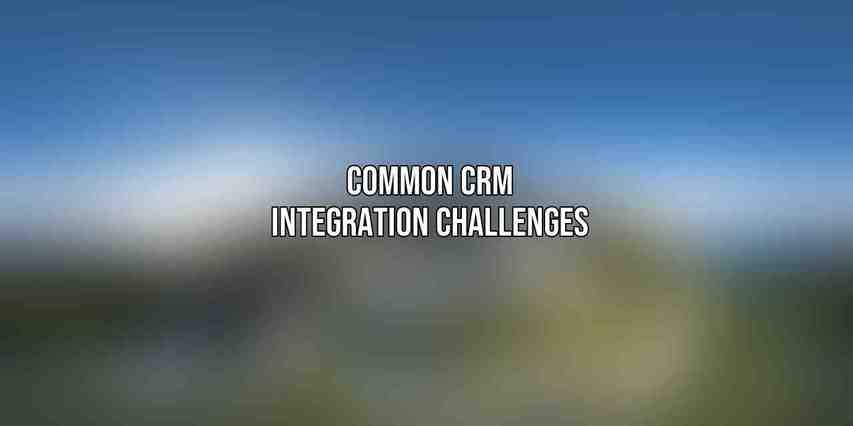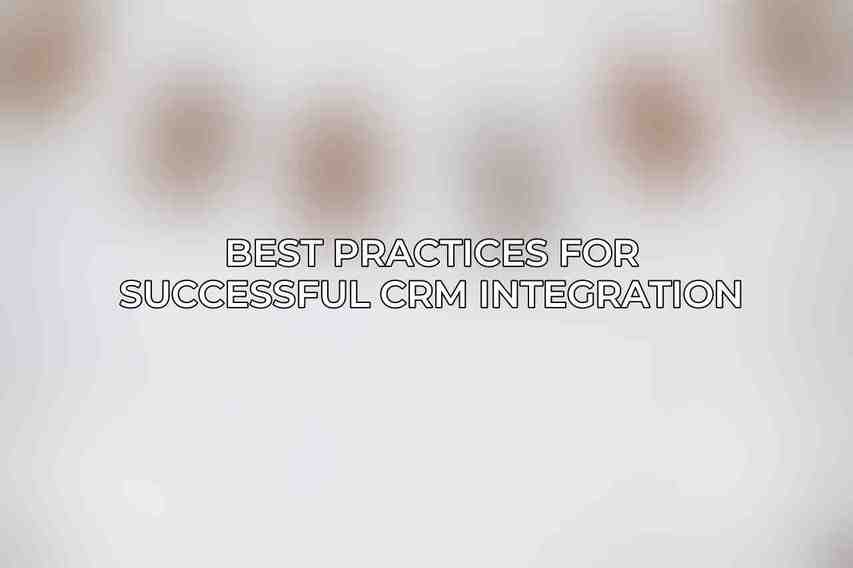Managing customer relationships is crucial for businesses, but integrating Customer Relationship Management (CRM) systems can be a complex process. CRM integration challenges often hinder organizations from leveraging the full potential of their customer data and interactions. From technical issues to user adoption barriers, these challenges can impede the seamless flow of information within an organization. Addressing these challenges is vital for companies looking to streamline processes, improve customer service, and drive growth.
Common CRM Integration Challenges

When it comes to CRM integration, several common challenges arise, impacting various aspects of the integration process. These challenges can be categorized into Technical Issues, Data Synchronization, and User Adoption hurdles.
A. Technical Issues
- Data compatibility and mapping: Ensuring that data from different systems can communicate and be translated accurately is essential for a successful integration.
- System performance and scalability: Integrating systems without compromising performance or hindering scalability is a key technical challenge.
- Integration with legacy systems: Connecting modern CRM systems with outdated legacy systems poses compatibility and interoperability challenges.
B. Data Synchronization
- Data integrity and consistency: Maintaining data accuracy and consistency across integrated systems is essential for informed decision-making.
- Data redundancy and duplicates: Ensuring that data is not duplicated or inconsistently stored across systems is a common synchronization challenge.
- Data latency and real-time availability: Achieving real-time data synchronization to enable timely decision-making and responsiveness can be a significant hurdle.
C. User Adoption
- Resistance to change: Overcoming resistance to new systems and processes among employees is crucial for successful CRM integration.
- Lack of training and support: Insufficient training and support for users can hinder adoption and utilization of the integrated CRM system.
- Usability and accessibility concerns: Poor user interface design or lack of accessibility features can impede user engagement and adoption of the integrated CRM system.
Solutions to CRM Integration Challenges
To overcome these challenges, organizations can implement a range of Technical Solutions, Data Synchronization Solutions, and User Adoption Solutions.
A. Technical Solutions
- Data Mapping and Transformation Tools: Utilizing data integration tools and Enterprise Service Bus (ESB) solutions can facilitate seamless data transformation and mapping.
- Cloud-Based Integration Platforms: Leveraging Integration Platform as a Service (iPaaS) and cloud-based data integration tools can simplify the integration process and enhance flexibility.
- Legacy System Migration and Modernization: Employing data migration tools and strategies for modernizing legacy systems can facilitate smoother integration with modern CRM platforms.
B. Data Synchronization Solutions
- Data Synchronization Software: Utilizing real-time and batch data synchronization tools can ensure data consistency and availability across integrated systems.
- Data Quality Management: Implementing data cleansing tools and governance processes can enhance data quality and integrity.
- Data Replication and Federation: Applying data replication techniques and federation tools can streamline data sharing and accessibility across systems.
C. User Adoption Solutions
- Change Management Strategies: Implementing effective communication, training programs, and involving users in the integration process can help overcome resistance to change.
- Training and Support: Providing comprehensive training materials and establishing a dedicated support team can enhance user understanding and utilization of the integrated CRM system.
- Usability Enhancements: Focusing on intuitive user interfaces, gamification, and incentives can improve user experience and adoption rates.
Best Practices for Successful CRM Integration

To ensure successful CRM integration, organizations should adhere to best practices that guide them through the integration process effectively.
A. Establish a Clear Integration Strategy
- Define integration goals and objectives: Clearly outlining integration goals helps align stakeholders and set expectations for the integration process.
- Identify integration touchpoints and data requirements: Understanding where data needs to flow and what data is essential for business operations is crucial for a successful integration.
B. Engage Stakeholders and Get Buy-In
- Involve key stakeholders from all affected departments: Collaborating with stakeholders ensures that all perspectives are considered during the integration.
- Secure approvals and commitment: Gaining buy-in from key decision-makers ensures support for the integration process and its successful implementation.
C. Choose the Right Integration Solution
- Evaluate integration tools and platforms: Assessing different integration solutions based on scalability, performance, and security requirements can help organizations choose the most suitable option.
- Consider scalability, performance, and security: Ensuring that the chosen integration solution can scale with business growth, maintain performance levels, and uphold data security is essential for long-term success.
D. Implement a Phased Approach
- Break down integration into manageable chunks: Dividing the integration process into smaller phases allows for easier management and reduces the risk of overwhelming changes.
- Prioritize integration tasks: Identifying critical integration tasks and prioritizing them based on business needs can ensure a structured and systematic approach to integration.
E. Monitor and Maintain the Integration
- Establish performance metrics: Defining key performance indicators (KPIs) helps organizations track the success of the integration and identify areas for improvement.
- Monitor integration performance and make adjustments as needed: Regularly monitoring the integration process allows for timely adjustments to optimize performance and address any emerging challenges.
Addressing and overcoming CRM integration challenges is essential for organizations looking to harness the full potential of their customer data and enhance operational efficiency. By implementing the right solutions and best practices, businesses can mitigate technical hurdles, streamline data synchronization, and ensure successful user adoption of integrated CRM systems. The benefits of successful CRM integration are numerous, including improved customer service, enhanced decision-making, and increased competitiveness in the market. As businesses navigate the complexities of CRM integration, prioritizing these challenges and implementing effective solutions is key to unlocking sustainable growth and success in the digital age. Call to action for businesses to prioritize CRM integration and embrace the opportunities it presents.
Frequently Asked Questions
What are the common challenges faced during CRM integration?
Common challenges during CRM integration include data migration issues, synchronization problems between systems, lack of standardization among platforms, and difficulty in aligning business processes.
How can businesses tackle data migration challenges during CRM integration?
Businesses can tackle data migration challenges by conducting a thorough data audit, mapping out data flows between systems, ensuring data quality and consistency, and utilizing data migration tools and automation.
What strategies can businesses adopt to address synchronization issues between CRM systems?
Businesses can address synchronization issues between CRM systems by implementing real-time data syncing solutions, ensuring data integrity, conducting regular data checks, and establishing clear communication channels between IT teams.
How important is standardization among CRM platforms for successful integration?
Standardization among CRM platforms is crucial for successful integration as it allows for seamless data exchange, consistent user experience, and easier collaboration among teams working on different systems. Check this blog on Email Marketing and CRM Integration: How to Guide
What role does business process alignment play in overcoming CRM integration challenges?
Business process alignment plays a significant role in overcoming CRM integration challenges by ensuring that workflows across systems are streamlined, employees are trained on new processes, and that the overall integration meets business objectives and requirements.

